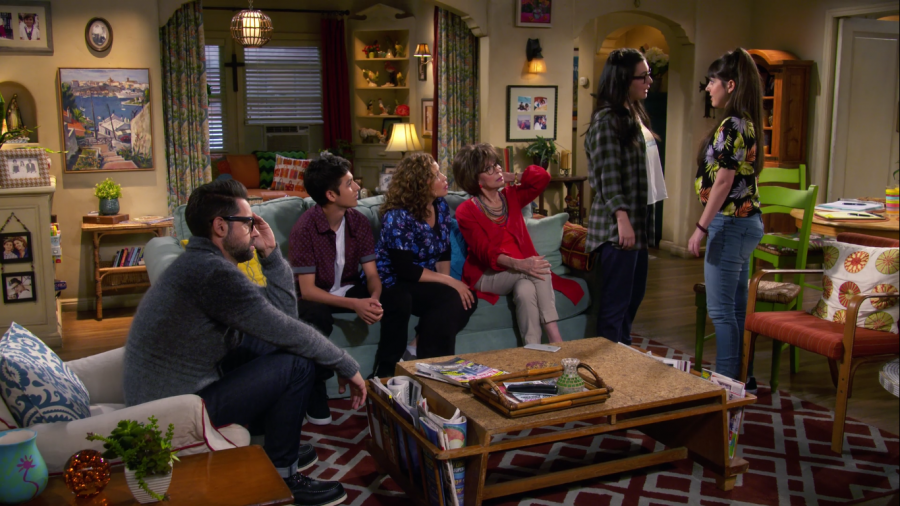Netflix’s third season of “One Day at a Time” raises the bar for the comedy-drama genre
Netflix
The third season of “One Day at a Time” returns with ever more sociopolitical charge, explored by the interactions and thoughts of its diverse characters.
March 30, 2019
Though insightful, Netflix sitcom “One Day at a Time” sacrifices genuine conversations to make its political statements.
The show is the reboot of a sitcom of the same name. The first “One Day at a Time” aired in the ’70s, and its plot lines are paralleled in the remake. Both center on a woman who is separated from her husband and must find her way in the world while guiding her two children. Unlike the original, which is set in Indianapolis, the adaptation follows a Cuban family living in Los Angeles.
The remake is drastically different in that it is largely based on the life of executive producer and writer Gloria Calderon Keller, who grew up with Cuban immigrant parents. Keller’s stories greatly influence the plot and setting of the show, bringing a degree of authenticity to the story.
The show’s protagonist is the mother, Penelope Alvarez (Justina Machado), a war veteran who struggles with PTSD, anxiety and depression. Isabella Gomez and Marcel Ruiz play her children Elena and Alex Alvarez. The fabulous Rita Moreno plays the grandmother, Lydia Riera, a first generation immigrant who is learning to accept old age and the beliefs of the new generation. Schneider is the quirky landlord, and Penelope’s best friend. He struggles with alcoholism and rejection. Dr. Berkowitz is her friend, and Penelope’s boss. He struggles with anxiety and self doubt throughout the series.
To comment on the happenings of America, the writers have the characters converse, each filling a niche that simultaneously reflects a real family and ongoing socio-political events.
For example, Elena and Lydia show the stark contrast in different generations. Their banter is reflective of a genuine multigenerational family, making the show relevant and enjoyable, but they also provide real commentary on current events.
Each character falls into a stereotype and represents that demographic. These archetypes remain constant for each season, but the characters develop within them.
The show greatly develops many side characters this season by giving them more screen time. For example, Dr. Berkowitz enacts a story about his children and the relationship he has with them. It is brief, but it hints at a stronger prevalence in future seasons. This adds dimension to his character and explains why he is so present with the Alvarez family.
Due to its complex characters and strong writing, “One Day at a Time” is also one of the most gender- and ethnicity-inclusive shows. It covers a wide range of issues and utilizes a diverse cast and crew.
The show has many underrepresented communities as main characters, which is rare in a sitcom. It explores the LGBTQ, mental health and immigrant communities in great detail and represents them in admirable ways.
“One Day at a Time” makes a strong effort to be socially relevant. It covers topics such as gentrification, illegal immigration and marijuana usage. To be understandable, the show has to include many definitions and detailed explanations; the writers do well in that sense, but they lack in giving that information in a natural way.
The background information is generally disguised in a question and answer format, which Schneider and Elena do well. Schneider will express a gap in his knowledge, and Elena will explain it to him, which also explains it to the viewers. It’s funny, natural and informative because the actors have such good chemistry.
Sometimes, however, they ask questions that do not fit in simply for the purposes of answering the question. It’s brief and not very distracting, but it gives the show a more “cheesy” feeling, rather than the feel-good comedy the writers aim for. They struggle to naturally include basic definitions because the characters are generally informed, but they are great at putting in more detailed explanations.
In season three, the show plays with different styles and formats, specifically in time and color. This is most notable in season three, episode nine: “Anxiety”.
The entire episode is based around Penelope telling her female veterans’ support group about her struggles. A flashback to her recent anxiety attacks illustrates her worst nightmares, usually the worst case scenario for the situations she finds herself in.
These mental constructs materialize in front of her in black and white. This allows the viewer to empathize with the feelings Penelope faces; they feel overwhelmed, scared and confused, a fantastic portrayal of the harsh realities of a panic attack.
The first two seasons bear a specific event the characters work toward, which is established in the first few episodes. In contrast, the third season did not distinguish a specific event: rather, it resolves three different points of conflict. It feels rushed and forgettable because it has so many different plot lines to conclude and does not satisfactorily conclude them all. For example, Penelope studies for her exams to become a nurse practitioner for the duration of the season, but the show skips over her actual testing.
The show has potential to start important discussions, which can change the ideology of many people. But the show has one problem, which prevents this ideal: it is extremely liberal. The characters have discussions, but they lean left and are not always respectful of other viewpoints. This limits the people they can reach, lessening its potential effect.
This narrow audience is likely the reason “One Day at a Time” did not get a fourth season. A social media campaign was launched to get the show more views, so Netflix would give it a new season. #renewodaat was trending for some days, and many major news outlets such as Forbes, Vulture and Buzzfeed wrote about why the show should continue.
Despite media pressure, on March 14 the show was officially canceled. Netflix tweeted, “We spent several weeks trying to find a way to make another season work, but in the end simply not enough people watched to justify another season.”
Fans are outraged over the cancelation of one of Netflix’s best shows. They blame the lack of marketing as justification for low views. The cast was not on many major talk shows, and the promotion was not up to par, showcasing a cheesy sitcom and missing the more serious aspects of the plot.
The show is currently fighting to be picked up by another network. “One Day at a Time” is loved by the internet and critics alike, so many networks may want it.
“One Day at a Time” is extremely relevant to current times, and well worth the watch. It embraces diversity in its cast and crew, which is apparent with its fascinating plotlines and storytelling. However, It falters in many regards. It covers complex political topics but does not explain them in a natural way, making them seem cheesy and inorganic. Nevertheless, the show expertly treads the line between gravity and comedy, raising viewer expectations for future comedy-dramas.





